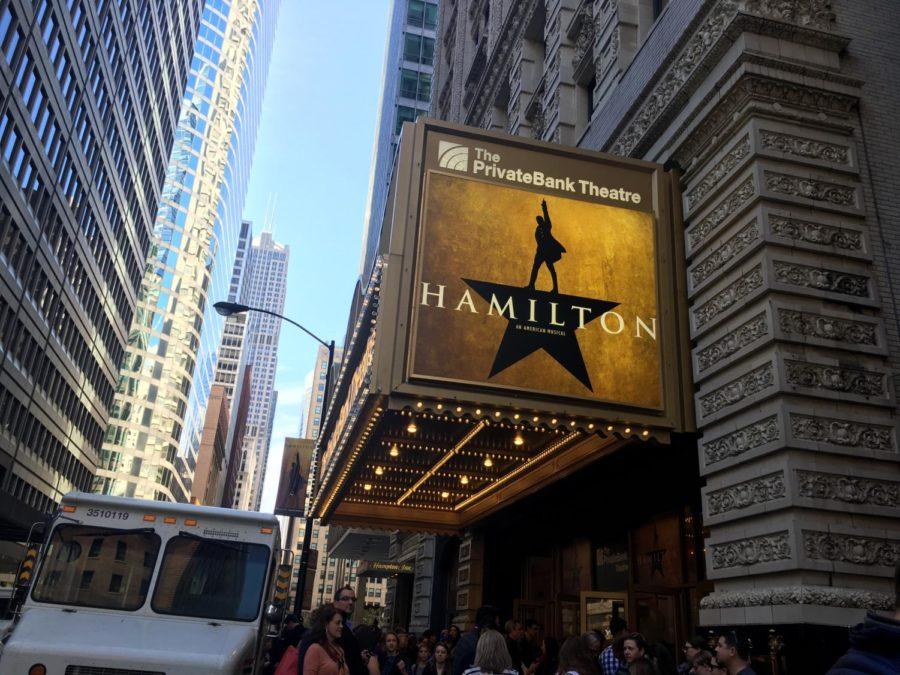Lin-Manuel Miranda’s staggeringly successful musical is in its third month here in Chicago, and all signs indicate that it’s here to stay. I was lucky enough to sit in a packed house this past weekend. My view from the cheap seats was obstructed such that I had to crane my neck the entire performance, but I was delighted to see this show in my city at last.
The musical may proclaim New York to be the “greatest city in the world,” but to me, Hamilton means something special to Chicago, a city that is diverse yet massively segregated. The city’s art scene is in the middle of a push for greater representation of people of color, but the difficulties inherent in these challenges are evident. This past October, for instance, a Second City actor quit his job after experiencing repeated racist remarks from audience members. This is by no means an isolated incident—artists city-wide are grappling with how to make their voices heard.
Meanwhile, Hamilton is poised to be not just a success in Chicago, but perhaps a healing force. Its story reaches people far beyond Broadway lovers in the Big Apple (so long as they’re willing to shell out hundreds of dollars per ticket). So many people believe in the transformative—need I say revolutionary?—power of this show: Its race-conscious casting promises unprecedented opportunities for people of color, while its inimitable pace excites both performers and audience members.
I cannot overstate the successes of the Chicago cast. Joshua Henry as Burr grips the audience’s attention from the moment he takes the stage and doesn’t let go. Karen Olivo’s Angelica is the definition of girl power. Chris De’Sean Lee, a young debut performer, astounds in his dynamic portrayals of Lafayette and Jefferson. The entire cast as a whole has an incredible collective power that left me wanting more at curtain time. I could go on.
Even so, Hamilton in Chicago is not completely what I envisioned. Sure, I felt a unity with the audience around me as tears rolled down our faces during “It’s Quiet Uptown” (and, let’s be honest, innumerable moments before and after that). But I was forced to confront a glaring reality: The audience with whom I shared this experience was enormously, undeniably white.
The show’s entire cast asks a simple question as Alexander Hamilton’s life draws to a close: Who tells your story? After seeing this show, I wondered, Who hears it? If the answer is almost exclusively affluent white Americans, then it hasn’t reached far enough yet. Not by a long shot.
A follow-up question: What do they hear? For many, Hamilton presents an intoxicating promise of progress. In a time of such political strife, it’s tempting to think of Hamilton as a narrative that offers a completely new lens for viewing our nation’s founders. One might think looking through it would uncover every inner working of racism, sexism, and oppression. And that we could unlock the secret to solving them.
Hamilton, however, is not a simple salve for our political wounds, and it never claimed to be. From its first beat to final note, Hamilton tells a familiar and not all-too-revolutionary story: one of rags to riches, of progress, of the American dream. The Hamilton difference is the shift in perspective of the narrator, the glimmer at the beginning of a long effort to reexamine our history and ourselves. I can only hope that the show’s largely white audiences of today, tomorrow, and probably several sold-out months from now leave the theater motivated to engage in politics for the ideals that are so easy to applaud after spending several hundred dollars on a seat.
Without a doubt, Hamilton left me expecting more: more opportunities to engage with art of this caliber, and not just for those who can afford admission. More involvement in issues that matter to our country. More growth, inclusion, and risks by artists and audiences alike to explore something entirely new to them. Mostly, more listening. If you ask me, that is exactly the reaction the show should elicit. Chicago is just Hamilton’s first stop out of New York. Going forward, I have no doubt in the show’s ability to grow as a piece of art, as a community, and as an inspiration for works to come.









